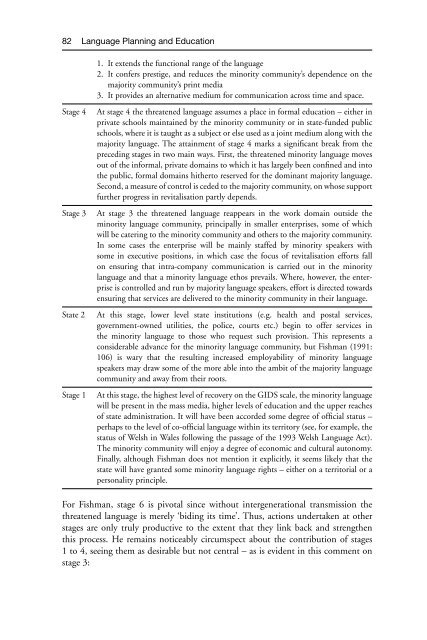Gibson Ferguson Language Planning and Education Edinburgh ...
Gibson Ferguson Language Planning and Education Edinburgh ...
Gibson Ferguson Language Planning and Education Edinburgh ...
You also want an ePaper? Increase the reach of your titles
YUMPU automatically turns print PDFs into web optimized ePapers that Google loves.
82 <strong>Language</strong> <strong>Planning</strong> <strong>and</strong> <strong>Education</strong><br />
1. It extends the functional range of the language<br />
2. It confers prestige, <strong>and</strong> reduces the minority community’s dependence on the<br />
majority community’s print media<br />
3. It provides an alternative medium for communication across time <strong>and</strong> space.<br />
Stage 4 At stage 4 the threatened language assumes a place in formal education – either in<br />
private schools maintained by the minority community or in state-funded public<br />
schools, where it is taught as a subject or else used as a joint medium along with the<br />
majority language. The attainment of stage 4 marks a significant break from the<br />
preceding stages in two main ways. First, the threatened minority language moves<br />
out of the informal, private domains to which it has largely been confined <strong>and</strong> into<br />
the public, formal domains hitherto reserved for the dominant majority language.<br />
Second, a measure of control is ceded to the majority community, on whose support<br />
further progress in revitalisation partly depends.<br />
Stage 3 At stage 3 the threatened language reappears in the work domain outside the<br />
minority language community, principally in smaller enterprises, some of which<br />
will be catering to the minority community <strong>and</strong> others to the majority community.<br />
In some cases the enterprise will be mainly staffed by minority speakers with<br />
some in executive positions, in which case the focus of revitalisation efforts fall<br />
on ensuring that intra-company communication is carried out in the minority<br />
language <strong>and</strong> that a minority language ethos prevails. Where, however, the enterprise<br />
is controlled <strong>and</strong> run by majority language speakers, effort is directed towards<br />
ensuring that services are delivered to the minority community in their language.<br />
State 2 At this stage, lower level state institutions (e.g. health <strong>and</strong> postal services,<br />
government-owned utilities, the police, courts etc.) begin to offer services in<br />
the minority language to those who request such provision. This represents a<br />
considerable advance for the minority language community, but Fishman (1991:<br />
106) is wary that the resulting increased employability of minority language<br />
speakers may draw some of the more able into the ambit of the majority language<br />
community <strong>and</strong> away from their roots.<br />
Stage 1 At this stage, the highest level of recovery on the GIDS scale, the minority language<br />
will be present in the mass media, higher levels of education <strong>and</strong> the upper reaches<br />
of state administration. It will have been accorded some degree of official status –<br />
perhaps to the level of co-official language within its territory (see, for example, the<br />
status of Welsh in Wales following the passage of the 1993 Welsh <strong>Language</strong> Act).<br />
The minority community will enjoy a degree of economic <strong>and</strong> cultural autonomy.<br />
Finally, although Fishman does not mention it explicitly, it seems likely that the<br />
state will have granted some minority language rights – either on a territorial or a<br />
personality principle.<br />
For Fishman, stage 6 is pivotal since without intergenerational transmission the<br />
threatened language is merely ‘biding its time’. Thus, actions undertaken at other<br />
stages are only truly productive to the extent that they link back <strong>and</strong> strengthen<br />
this process. He remains noticeably circumspect about the contribution of stages<br />
1 to 4, seeing them as desirable but not central – as is evident in this comment on<br />
stage 3:






